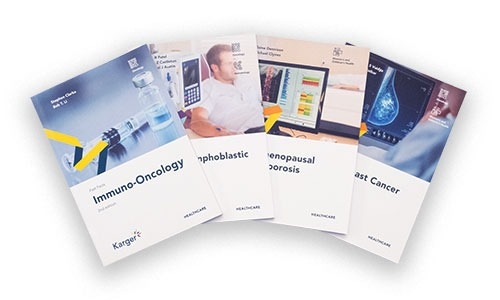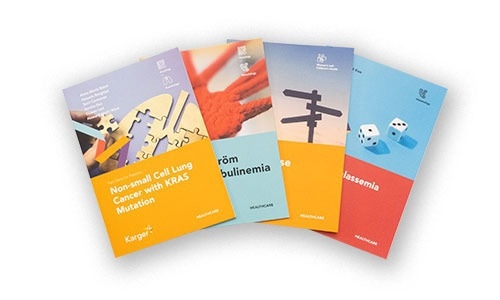Sponsored Content by S. Karger AGReviewed by Louis CastelDec 17 2024
In this interview, NewsMedical talk to Karger S. Karger AG's Sharon de Botte about the Fast Facts series.
Fast Facts marks its 30th anniversary this year. Can you share with us the initial vision behind the series and how it first came into existence?
Fast Facts was Sarah Redston's brainchild. Having worked in medical publishing and Med Comms for several years, she saw a gap in the market for, as she liked to call it, ‘refreshingly readable’ material that met the needs of busy healthcare professionals whose time was at a premium.
She set up Health Press Ltd, an independent medical publishing company, in a spare room in her house. From there, she set about building the Fast Facts series, with each title designed to bring clinicians up to speed quickly on a specific condition, therapeutic area or topic in medicine.
For each book, she commissioned two Key Opinion Leaders (KOLs) from different countries, usually on different sides of the Atlantic, to give the content an international perspective, with any differences in practice or guidelines between geographic regions being discussed within the text.
In 1994, she published the first Fast Facts handbook for clinicians on prostate cancer. We published the eleventh edition of that title this year.

Image Credit: S. Karger Publishers
What unique needs in healthcare publishing did Fast Facts initially set out to address, and how has that vision evolved over the years?
The Fast Facts titles were (and still are) aimed at a broad range of healthcare professionals and aimed to address the largest educational gaps in healthcare. The goal was to provide all members of the multidisciplinary healthcare team with a concise but comprehensive primer on a specific condition or topic in medicine.
The readership includes primary care providers, junior hospital doctors, specialist nurses, and specialist trainees. Some titles have been popular with medical students, and we have also heard, anecdotally, that the books are popular with consultants reading outside their field of expertise. Several Fast Facts titles have also been used for internal training within pharma companies to bring their medical affairs team up to speed in a particular disease area.
Each Fast Facts title is independent, highly readable, and visually appealing, providing detail and depth on a topic. Each chapter ends with a list of key points that reiterate the principal take-away messages, and the data are fully referenced.
Although the series has undergone several design changes over the years, the format of the books has remained the same—because it works. The series was well thought out and received at the start, winning multiple BMA Book Awards and commendations. So, ‘if it ain’t broke, don’t fix it.’
As the series has grown, how have Fast Facts eBooks adapted to meet the changing demands of healthcare professionals and patients alike?
Healthcare professionals are still ridiculously busy, with many demands on their time, and we know that everyone has different ways of assimilating information, be it by reading, listening or watching. So, in recent years, we have been finding different ways of providing ‘Fast Facts’, for example, in the form of interactive eLearning programs, podcasts, videos, animations, and plain language summaries, so that there is a format to suit everyone.
Importantly, we have also expanded the Fast Facts offering to patients with a series of workbooks that help to facilitate the conversation between patients and their healthcare team, alongside summary information sheets for newly diagnosed patients. Patients and patient advocacy groups (PAGs) are involved in content creation from the start of every patient resource so that the patient's voice is truly heard. These resources were recently awarded the PIF tick, reflecting our role as a Trusted Information Creator, producing health information of real value that is evidence-based, up-to-date, and easy to use and understand.
Can you walk us through the process of creating a Fast Facts title? What steps are taken to ensure the content is both accessible and authoritative? How do you check the quality (and compliance) of the content?
When we identify educational gaps or unmet needs in a specific area, we begin by developing a content outline that aligns with the target audience's needs while considering the desired learning objectives and outcomes. Next, we commission 2-3 (or sometimes more) KOLs, discuss the goals and framework with them, and allow time for them to prepare an initial draft. For patient resources, we collaborate with patients, patient advocacy groups (PAGs), and clinical reviewers to ensure the content is accurate, relevant, and patient-centered.
Experienced editors with extensive industry expertise, including myself, refine the manuscript to ensure it aligns with compliance requirements and best practices. This collaborative process continues until both Karger and the author team or faculty are satisfied that the content hits the mark. Once the manuscript is typeset, the first proof is shared with all relevant stakeholders, including authors, peer reviewers (HCPs and/or patients), and pharmaceutical companies. All feedback is carefully collated, but the independent author team or faculty retains the final authority over the content.

Image Credit: S. Karger Publishers
In what ways has technology influenced the distribution and accessibility of Fast Facts over the years? How has this impacted your readership?
As mentioned earlier, Fast Facts has evolved beyond printed books into a wide range of formats, including eBooks and eLearning, most of which are freely accessible online. This digital expansion allows us to reach a much broader audience worldwide. The growing number of translations within the Fast Facts series reflects this global reach and accessibility.
With everything online, we can also look at the metrics (downloads, course participant numbers, number of viewers, and direct feedback) to find out what works and what doesn’t so that we can continually adapt our products to meet the needs of busy HCPs and patients looking for authoritative, trusted information.
One of the standout features of Fast Facts is the concise, clear way information is presented. How do you achieve this balance between depth and accessibility, especially on complex medical topics?
Firstly, our authors often write with their junior colleagues in mind, ensuring they provide the right level of detail and the most relevant information. I’d also like to give a big shoutout to the editors—this is experienced editing at its finest.
Despite the growing use of AI in publishing, I firmly believe the role of the Developmental Editor is irreplaceable. An experienced editor who can transform a wordy, sometimes disorganized document into concise, logically ordered, and engaging content is truly invaluable. Developmental editing goes beyond copyediting; it often involves substantial writing and rewriting. We dedicate significant time to this stage of the process, ensuring our products are of the highest quality. This includes incorporating all aspects of the initial content outline and collaborating closely with our authors to strike the perfect balance of information.
Looking at today’s healthcare landscape, what new trends or challenges are influencing the direction of Fast Facts publications?
Our independent content is funded by pharmaceutical companies, either directly or through educational grants. This means we carefully consider the needs of industry funders alongside those of HCPs and patients. We ask key questions: Who do they want to reach? How do they want to engage with their audience? With so many ways to deliver information today, our focus is on finding the right approach for all stakeholders.
We’ve seen significant growth in our titles on rare diseases, which has been incredibly rewarding. Providing high-quality information for HCPs and patients in areas where resources are often limited or of poor quality is a vital part of what we do. Increasingly, patients are involved from the outset of our projects, ensuring their questions and perspectives are fully integrated into the final product. This patient-centered approach is crucial. As communicators, we have the tools to foster better dialogue between patients and HCPs, ultimately leading to improved outcomes. To enhance this, we’re currently developing shared decision-making aids as part of our expanding offering.
Our authors and faculty members are more time-constrained than ever, so we do as much as we can to support them and make working with us a satisfying experience.
In today’s healthcare landscape, saturated with both good and bad information, it is more important than ever for us to produce high-quality, high-value resources that meet the needs of HCPs, patients, and industry partners alike.
Reflecting on the past 30 years, what do you think has been the most significant milestone or accomplishment for the Fast Facts series? And what are your hopes for the future of these publications?
I think the biggest accomplishment of Fast Facts has been its remarkable durability. From the first edition 30 years ago, the series has grown into a collection of over 130 titles, along with a range of patient resources and creative formats. It all started with a strong set of principles and a small, agile team that prioritized the quality of information above all else.
My hopes for the future are a twelfth edition of Fast Facts: Prostate Cancer and a trusted and respected portfolio of healthcare information products that consistently meet the needs of our readers. In short, I hope that we keep doing what we’re doing.
About the Speaker

Sharon started her career in publishing in journals, first as Editorial Assistant on the British Dental Journal before becoming News Editor and Deputy Editor of the weekly Veterinary Record. After taking a break to travel around the world (a late gap year), Sharon returned to publishing as UK Editorial Manager at Rogers Medical Communications agency. She later freelanced as a medical editor before joining Health Press in 2004 to work as Senior Healthcare Publications Editor on the Fast Facts series of medical handbooks. Karger Publishers acquired the Fast Facts series in 2018. When she isn’t editing or writing, Sharon can be found in the garden or on a tennis court.
About S. Karger Publishers
Connecting people and science since 1890, Karger provides scientists, healthcare professionals, patients, and the broader public with reliable and tailored information in Health Sciences.
Building upon a publishing portfolio of more than 100 reputable scholarly journals and the award-winning Fast Facts medical info series, Karger excels in medical education and omnichannel HCP engagement in multiple formats, including 3D animations, podcasts, AR/VR environments, and more. Academic institutions and both medical affairs and pharma marketing teams in the corporate space entrust Karger with their most demanding communication challenges. Independent and family-led in the fourth generation by Chairwoman Gabriella Karger, Switzerland-based Karger is present in 15 countries with a team of 200 dedicated professionals worldwide.